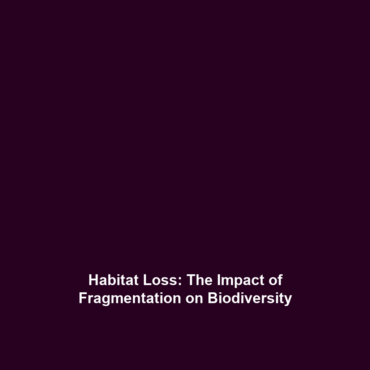Habitat Loss and Fragmentation: Fragmenting Ecosystems into Smaller Areas
Introduction
Habitat loss and fragmentation represent critical challenges in the realm of environmental conservation, significantly impacting biodiversity and ecosystem functionality. These processes, exacerbated by deforestation, lead to the degradation of habitats, disrupt ecological networks, and threaten the survival of countless species. Understanding habitat loss and fragmentation is essential for developing effective conservation strategies aimed at mitigating biodiversity loss and preserving ecosystems.
Key Concepts
Habitat Loss
Habitat loss refers to the complete elimination of ecosystems, often due to human activities such as agricultural expansion, urbanization, and deforestation. This loss results in decreased biodiversity as species struggle to survive in dwindling environments. Major factors contributing to habitat loss include:
- Industrial development
- Logging and deforestation
- Climate change
Fragmentation
Fragmentation involves breaking up large, connected habitats into smaller, isolated patches. This phenomenon can lead to several ecological consequences:
- Increased species extinction rates
- Altered species interactions
- Reduced genetic diversity
Together, habitat loss and fragmentation create a pressing need for effective ecological management and conservation initiatives aimed at maintaining biodiversity amidst rapid environmental change.
Applications and Real-World Uses
Understanding habitat loss and fragmentation has significant implications for conservation policies and land management. For instance:
- Conservation Planning: Strategies to restore fragmented habitats can enhance connectivity between ecosystems, which is crucial for species migration and genetic diversity.
- Urban Development Policies: Implementing green spaces in urban planning can mitigate some adverse effects of fragmentation.
- Development of Wildlife Corridors: These structures facilitate safe passage for species through fragmented landscapes, allowing for movement and resource access.
Addressing how habitat loss and fragmentation are utilized in conservation efforts enhances the understanding of their roles in mitigating deforestation and biodiversity loss.
Current Challenges
The study and application of habitat loss and fragmentation face numerous challenges, including:
- Data Limitations: Insufficient data on species population dynamics and habitat requirements can hinder effective conservation strategies.
- Climate Change: The impacts of climate change may render traditional preservation tactics less effective.
- Policy Implementation: Aligning biodiversity preservation with human economic interests remains a substantial hurdle.
These challenges necessitate ongoing research and interdisciplinary approaches to enhance conservation efficacy amid biodiversity loss.
Future Research and Innovations
Future research into habitat loss and fragmentation promises to yield innovative solutions that can reshape conservation efforts. Key areas of focus include:
- Genomic Technologies: Advancements in genomics can help identify genetic diversity within fragmented populations, informing targeted conservation actions.
- Remote Sensing: Utilizing satellite technology to monitor habitat changes and assess fragmentation on a global scale.
- Landscape Ecology: Ongoing studies in landscape connectivity and ecological networks may influence urban and rural planning.
Investments in these emerging fields hold the potential for transformative change in how we address habitat loss and fragmentation.
Conclusion
In summary, habitat loss and fragmentation pose significant threats to biodiversity and ecosystem health, particularly in the current context of deforestation. A comprehensive understanding of these processes is crucial for developing effective conservation strategies. Stakeholders, policymakers, and researchers are urged to collaborate in promoting habitat connectivity and restoring ecosystems. For more insights on biodiversity preservation, see our articles on Conservation Efforts and Deforestation Impact.
